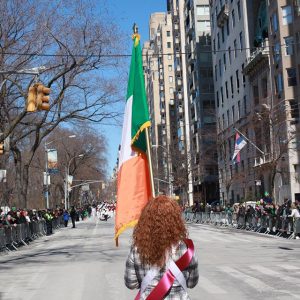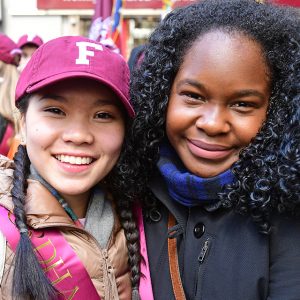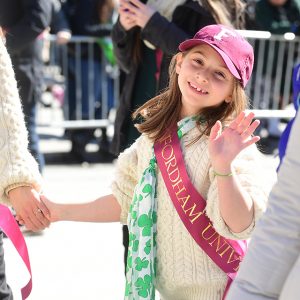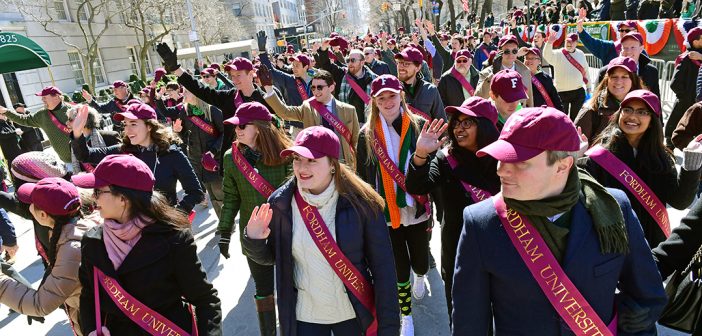
A young Ram heads up Fifth. (Photo Tom Stoelker)
But soon enough, blue skies and a bright sun betrayed remnants of a snowstorm that had hit the city just a few days earlier.
Harrison High School Marching Band, a neighbor of Fordham’s Westchester campus, led the Rams up Fifth Avenue. With members of Rose Hill campus’s Fordham Prep following just behind, the contingent created an impressive sea of maroon.
“If you have any bit of Irish in you, it’s a very good day!” said Peter Dolan, GABELLI ’71, ’75.
It was a day for Fordham to be especially proud as, this year, Michael Dowling, GSS ’74, president and chief executive officer of Northwell Health, served as grand marshal.
On the avenue, spectators took note of the size of Fordham’s contingent: “Go Rams!” “FUV!” “A beacon in the Bronx!” and “My friend goes there!” Rochelle Grubb, who said she has no affiliation with the University, led the Rams in a spontaneous cheer anyhow: “Give me an F! Give me an O! Give me an R! … ”
Immigrant Roots
The parade made its way past St. Patrick’s Cathedral, where marchers tipped their hats to Cardinal Timothy Dolan. Just beyond the bronze doors, behind a marble edifice that was built by immigrants, lay the tomb of Fordham founder Archbishop John Hughes. Those same immigrants were universally spurned by the nation when they arrived, said Joseph M. McShane, S.J., president of Fordham.

Peter Quinn, Father McShane, and Jane Bartnett leading the Rams
“When Archbishop Hughes came to the United States as an immigrant from Ireland, he had the faith and a burning desire to do well, but he had a deep sense of what it was to be an outsider,” said Father McShane. “He founded Fordham so that the Irish immigrants would break out of that terrible cycle of poverty that they lived in and had to contend with.”
“When the Irish came over, nobody gave them anything,” said Bob O’Kane, FCRH ’70. “We had to make our own way.”
Prior to the parade, nearly 200 alumni and friends gathered for a breakfast at the Yale Club’s Grand Ballroom. The surroundings were a reminder of how far the Irish had come, as was emphasized in a talk given by author Peter Quinn, GSAS ’75.
Toward Diversity
 In a humorous start, Quinn said the University’s Bronx Irish Catholic roots were so strong they were known as “BIC for short.” But Fordham’s Irish identity was soon complemented by a generous influx of Italians and others from the borough’s “ethnic Serengeti.” He spoke of a friendly Irish/Italian rivalry in which the Feast of St. Joseph was celebrated by Italians with equal fervor to St. Patrick’s Day, and where Irish-Italian “intermarriages” produced “some of the borough’s best-looking offspring.”
In a humorous start, Quinn said the University’s Bronx Irish Catholic roots were so strong they were known as “BIC for short.” But Fordham’s Irish identity was soon complemented by a generous influx of Italians and others from the borough’s “ethnic Serengeti.” He spoke of a friendly Irish/Italian rivalry in which the Feast of St. Joseph was celebrated by Italians with equal fervor to St. Patrick’s Day, and where Irish-Italian “intermarriages” produced “some of the borough’s best-looking offspring.”
Geralyn Neumann, FCRH ’86, affirmed his description. “When we went, Fordham was pretty diverse. There were a lot of Irish, Italians, and commuters from the Bronx community.”
Quinn said that in Ireland the holiday takes on a more subdued tone than in the United States.
From Struggle to Triumph
“That’s because when we celebrate Ireland’s national saint, we recall an American story of immigrant struggles, survival, and ultimate triumph,” he said. It is a story that began with a British imperial government that “put economic theory above human suffering and produced Europe’s greatest toll of civilian death between the Black Death and the World Wars.”
He said nearly 1 million Irish immigrants passed though New York City’s seaport. Once here, they were greeted with signs of “No Irish need apply” for jobs. The most famous cartoonist of the day, he said, portrayed them as apes.
 “But we applied anyway. We changed the country’s politics, transformed its cities, and defied those who claimed America was theirs alone,” he said. “We fought and died for the country’s wars, we insisted on the rights of working people, and we refused to accept the remains from the banquets of the few.”
“But we applied anyway. We changed the country’s politics, transformed its cities, and defied those who claimed America was theirs alone,” he said. “We fought and died for the country’s wars, we insisted on the rights of working people, and we refused to accept the remains from the banquets of the few.”
He said that the Irish eventually shared in the country’s successes, but today “we sometimes turn our back on those [being] denied what we had gained.”
He said that the Irish have proved that becoming American doesn’t mean “abjuring your religion [or] abandoning your heritage,” and asked marchers to to remember that as they passed by the cathedral.
“As we celebrate, we remember where we come from, our passage, a journey that took us to a day of liberty, equality, and inclusion that we Irish helped shape,” he said. “Remember that the dream is alive in each of us, and alive in the millions [of] dispossessed—those fleeing persecution, deprivation, starvation, those seeking some measure of hope and opportunity for their children.“These are not a faceless hoard of strangers … but the faces of our ancestors, an image of ourselves.”
While the Rams marched up Fifth Avenue, Fordham’s University Church joined institutions worldwide in ringing its bell for one minute in recognition of “Bells of Joy,” an initiative launched by former Irish President Mary McAleese to stand against hatred and fear of our immigrant brothers and sisters.



